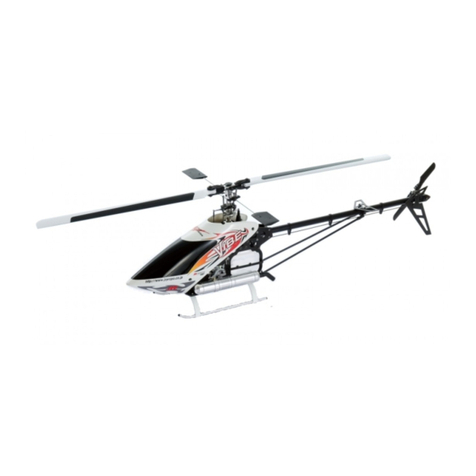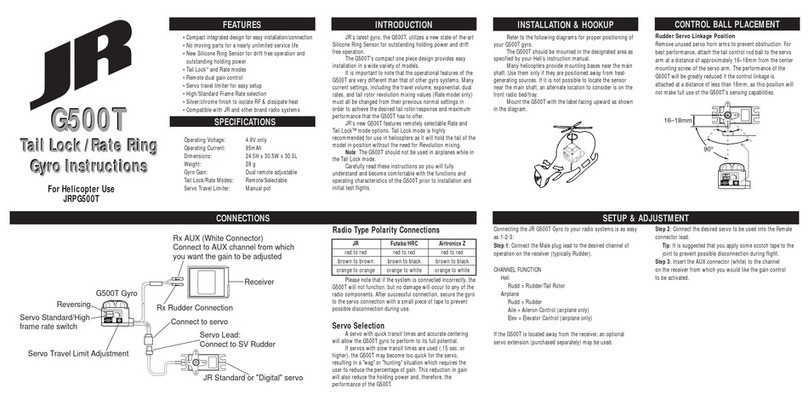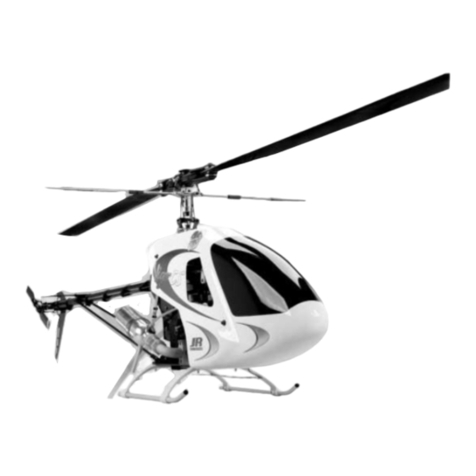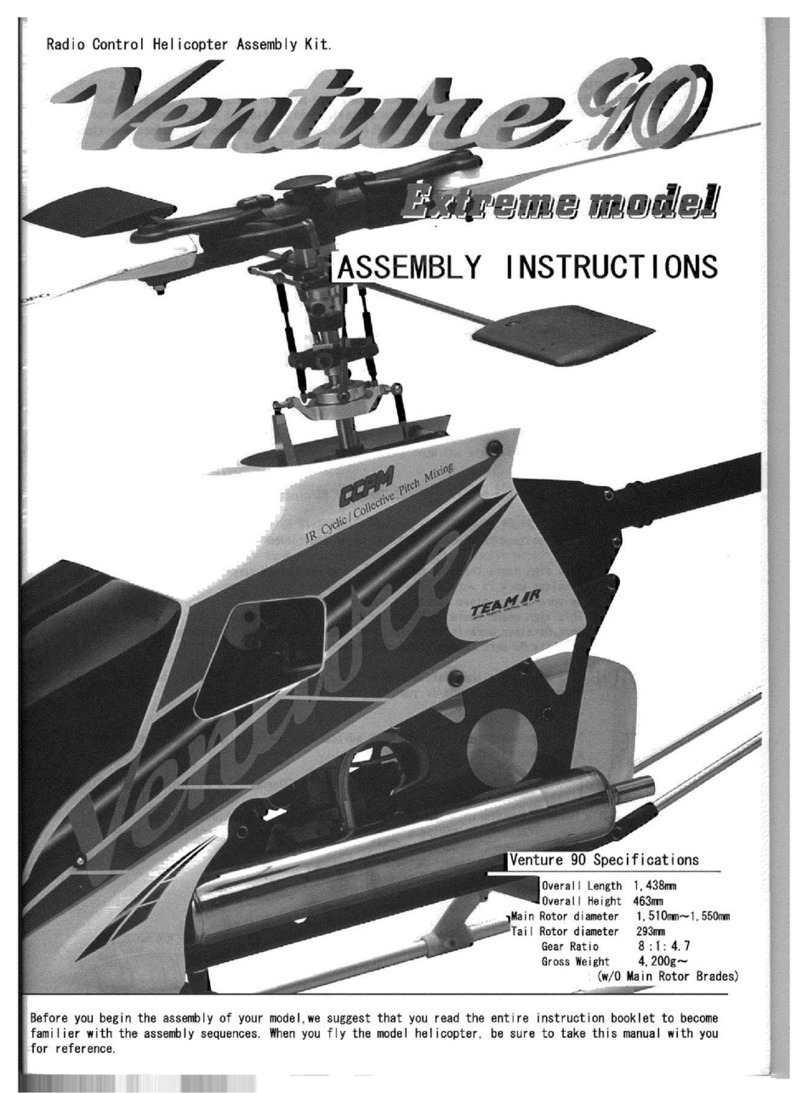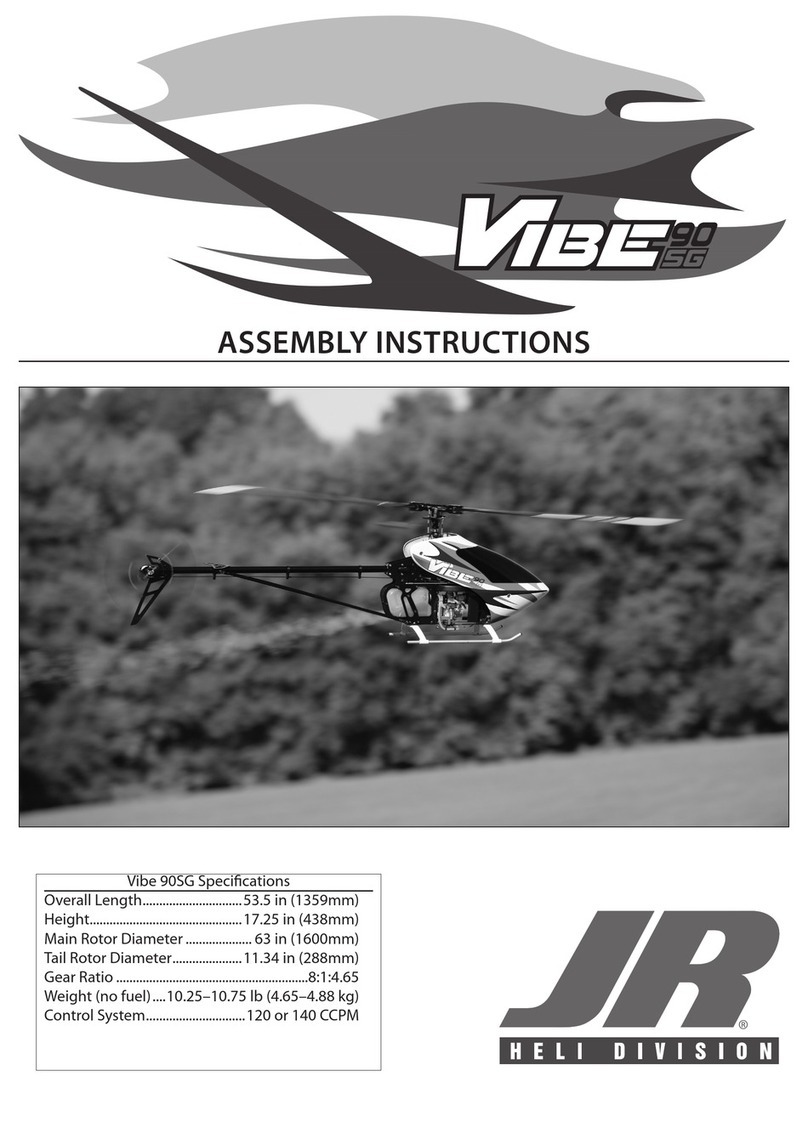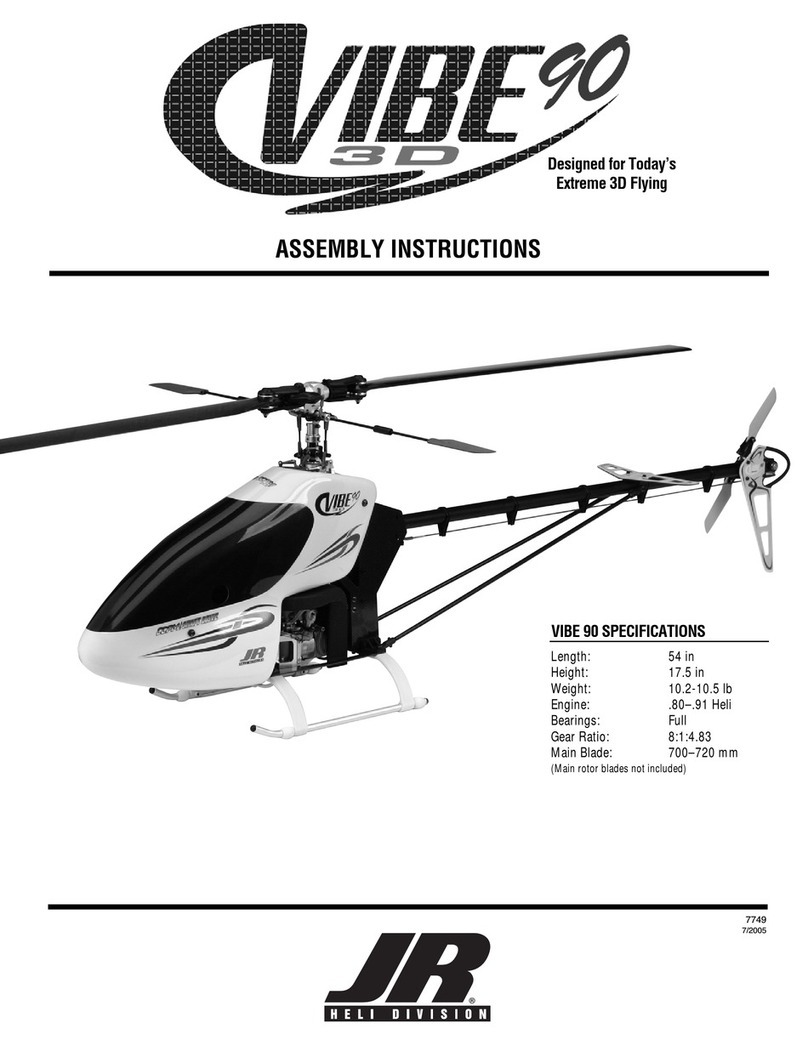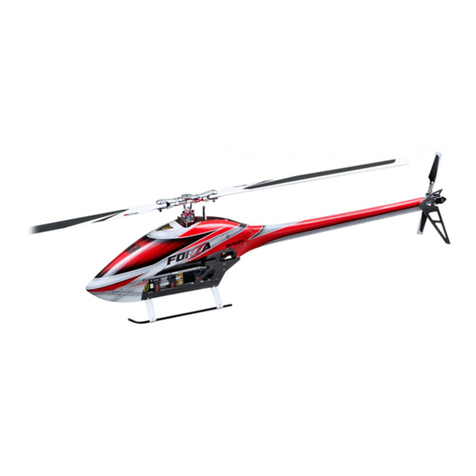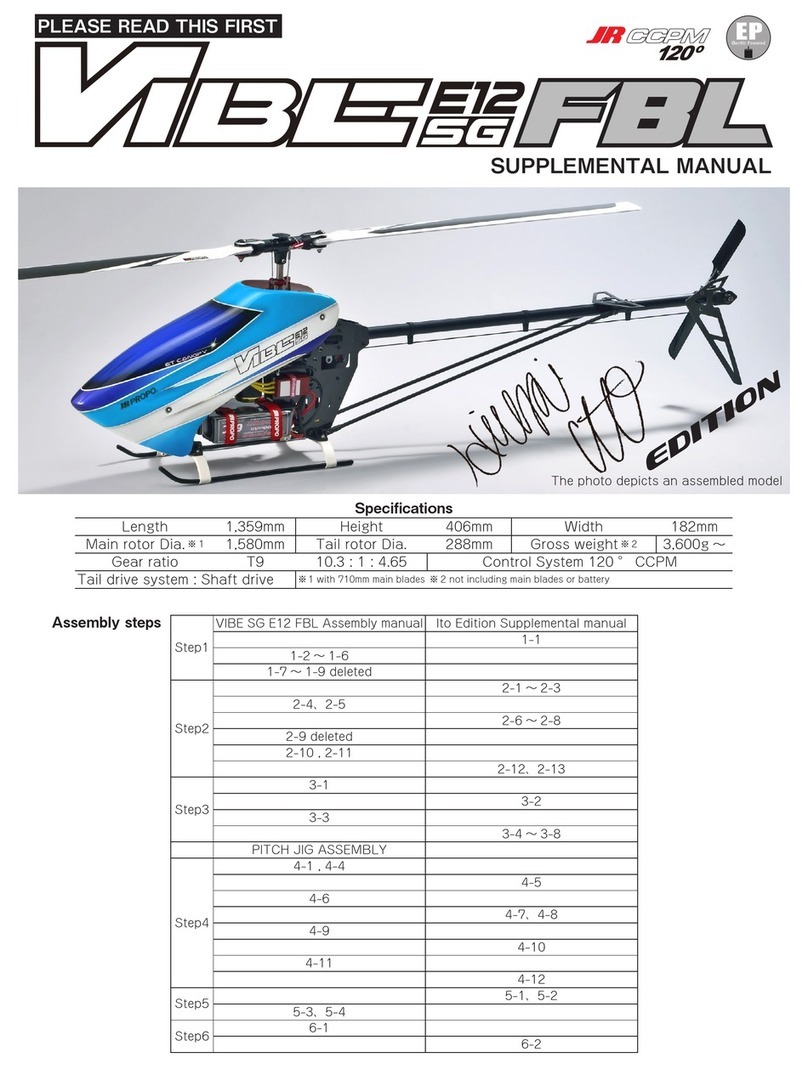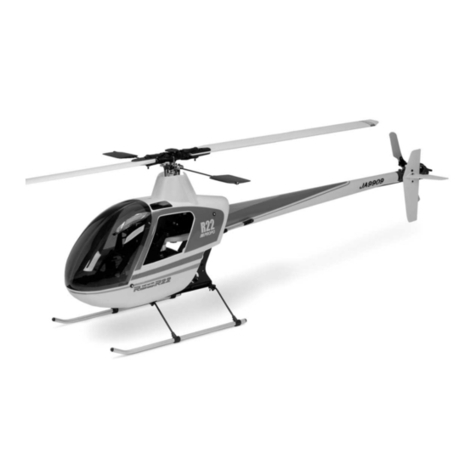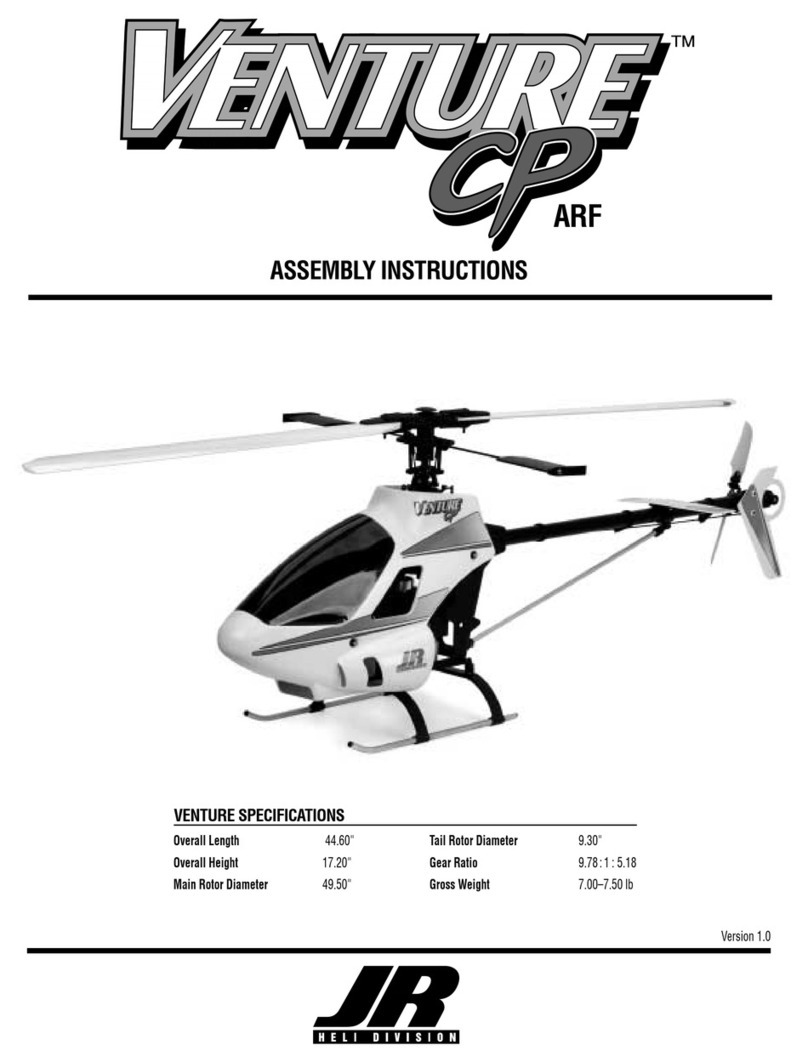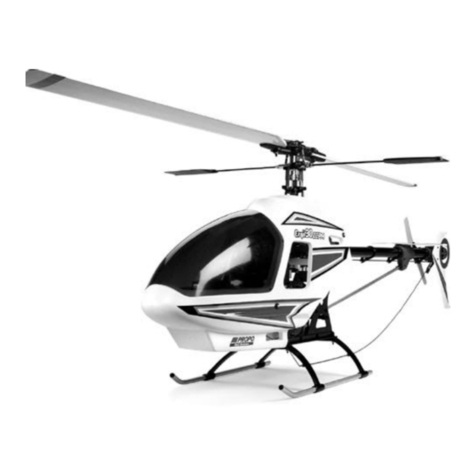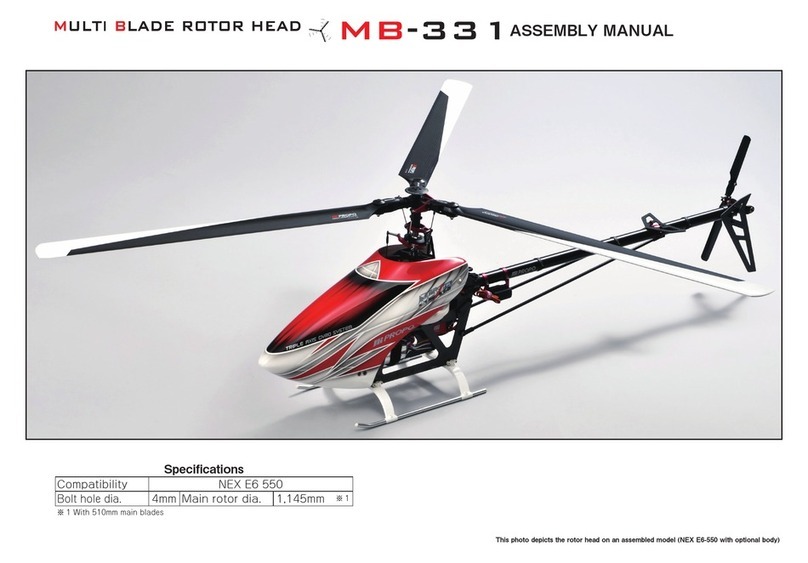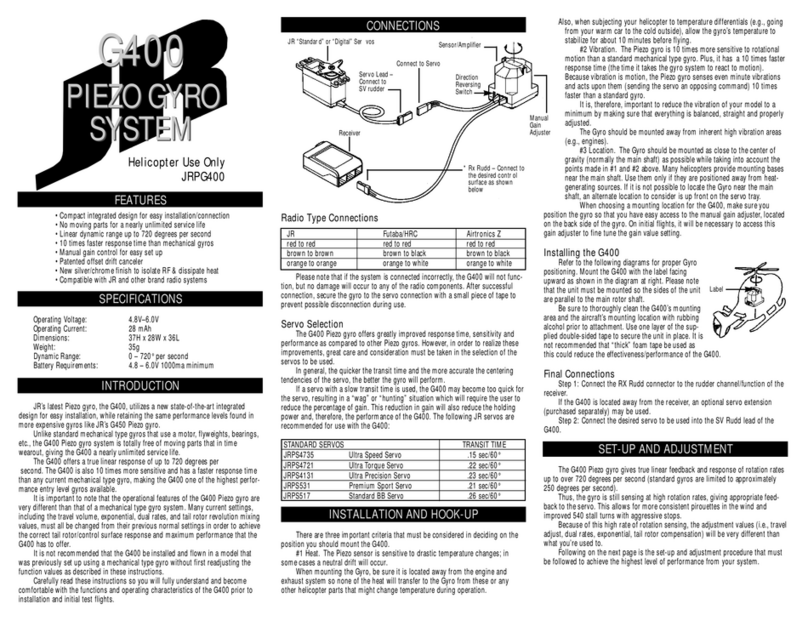2
Introduction . . . . . . . . . . . . . . . . . . . . . . . . . . . . . . . . . . . . . . . . . . . . . . . . . . . . 3
Venture 30 CP ARF Features . . . . . . . . . . . . . . . . . . . . . . . . . . . . . . . . . . . . . . . 4
Radio System Requirements . . . . . . . . . . . . . . . . . . . . . . . . . . . . . . . . . . . . . . . 4
Engine Requirements . . . . . . . . . . . . . . . . . . . . . . . . . . . . . . . . . . . . . . . . . . . . 5
Building Supplies . . . . . . . . . . . . . . . . . . . . . . . . . . . . . . . . . . . . . . . . . . . . . . . . 5
Required Tools . . . . . . . . . . . . . . . . . . . . . . . . . . . . . . . . . . . . . . . . . . . . . . . . . 6
Required Field Equipment . . . . . . . . . . . . . . . . . . . . . . . . . . . . . . . . . . . . . . . . . 6
Hardware Identification . . . . . . . . . . . . . . . . . . . . . . . . . . . . . . . . . . . . . . . . . . . 7
1-1 Tail Boom Installation. . . . . . . . . . . . . . . . . . . . . . . . . . . . . . . . . . . . 8
1-2 Drive Belt Connection and Adjustment. . . . . . . . . . . . . . . . . . . . . . . 8
1-3 Tail Boom Brace Installation. . . . . . . . . . . . . . . . . . . . . . . . . . . . . . . 9
1-4 Tail Fin Attachment. . . . . . . . . . . . . . . . . . . . . . . . . . . . . . . . . . . . . . 9
1-5 Tail Control Rod Assembly. . . . . . . . . . . . . . . . . . . . . . . . . . . . . . . 10
1-6 Tail Control Rod Installation/Horizontal Fin Attachment . . . . . . . . . 10
2-1 Engine Mount/Cooling Fan Installation. . . . . . . . . . . . . . . . . . . . . . 11
2-2 Clutch Assembly Attachment . . . . . . . . . . . . . . . . . . . . . . . . . . 11–12
2-3 Starter Shaft/Hex Adapter Installation . . . . . . . . . . . . . . . . . . . . . . 12
2-4 Engine Installation . . . . . . . . . . . . . . . . . . . . . . . . . . . . . . . . . . . . . 13
2-5 Muffler Installation. . . . . . . . . . . . . . . . . . . . . . . . . . . . . . . . . . . . . 13
3-1 Servo Installation . . . . . . . . . . . . . . . . . . . . . . . . . . . . . . . . . . . . . . 14
3-2 Gyro/Receiver/Switch Harness/Battery Installation . . . . . . . . . 15–16
Understanding Swashplate Control Systems . . . . . . . . . . . . . . . . . . . . . . . 17–18
How JR 120 CCPM Works . . . . . . . . . . . . . . . . . . . . . . . . . . . . . . . . . . . . . . . . 19
Radio System Requirements . . . . . . . . . . . . . . . . . . . . . . . . . . . . . . . . . . . . . . 19
CCPM Software Activation and Initial Adjustment . . . . . . . . . . . . . . . . . . . 20-23
Important CCPM Programming Guidelines . . . . . . . . . . . . . . . . . . . . . . . . . . . 24
3-3 CCPM Servo Arm Preparation and Installation. . . . . . . . . . . . . . . . 25
3-4 CCPM Servo Centering with the Sub-Trim Function. . . . . . . . . 26–27
3-5 CCPM Linkage Connection. . . . . . . . . . . . . . . . . . . . . . . . . . . . . . . 28
3-6 Checking the Swashplate for Level. . . . . . . . . . . . . . . . . . . . . . . . . 29
3-7 Pitch-to-Aileron Mixing Adjustment with Travel Adjust . . . . . . . . . 30
3-8 Pitch-to-Elevator Mixing Adjustment with Travel Adjust . . . . . . . . 31
3-9 Tail Control Rod Servo Connection . . . . . . . . . . . . . . . . . . . . . . . . 32
3-10 Throttle Linkage Installation. . . . . . . . . . . . . . . . . . . . . . . . . . . . . . 33
4-1 Body Assembly/Canopy Attachment . . . . . . . . . . . . . . . . . . . . . . . 34
4-2 Decal Attachment. . . . . . . . . . . . . . . . . . . . . . . . . . . . . . . . . . . . . . 35
4-3 Main Rotor Blade Balancing. . . . . . . . . . . . . . . . . . . . . . . . . . . . . . 36
4-4 Main Rotor Blade Attachment . . . . . . . . . . . . . . . . . . . . . . . . . . . . 36
4-5 Optional 3D Control System Setup. . . . . . . . . . . . . . . . . . . . . . 37–38
Radio Data Sheet: XP652/662 Basic Setup . . . . . . . . . . . . . . . . . . . . . . . . . . . 39
Radio Data Sheet: XP652/662 3D Setup . . . . . . . . . . . . . . . . . . . . . . . . . . . . . 40
Radio Data Sheet: X-378 Basic Setup . . . . . . . . . . . . . . . . . . . . . . . . . . . . . . . 41
Radio Data Sheet: X-378 3D Setup . . . . . . . . . . . . . . . . . . . . . . . . . . . . . . . . . 42
Radio Data Sheet: XP8103 Basic Setup . . . . . . . . . . . . . . . . . . . . . . . . . . . . . . 43
Radio Data Sheet: XP8103 3D Setup . . . . . . . . . . . . . . . . . . . . . . . . . . . . . . . . 44
Radio Data Sheet: PCM10X 3D Setup . . . . . . . . . . . . . . . . . . . . . . . . . . . . 45–46
Final Servo Adjustment and Radio Setup . . . . . . . . . . . . . . . . . . . . . . . . . . 47–49
Final Preflight Check . . . . . . . . . . . . . . . . . . . . . . . . . . . . . . . . . . . . . . . . . . . . 50
Blade Tracking Adjustment. . . . . . . . . . . . . . . . . . . . . . . . . . . . . . . . . . . . . . . . 50
Blade Tracking Identification . . . . . . . . . . . . . . . . . . . . . . . . . . . . . . . . . . . . . . 50
Advice and Basic Hover Training Practices . . . . . . . . . . . . . . . . . . . . . . . . . . . 51
General Maintenance. . . . . . . . . . . . . . . . . . . . . . . . . . . . . . . . . . . . . . . . . . . . 52
Troubleshooting Guide. . . . . . . . . . . . . . . . . . . . . . . . . . . . . . . . . . . . . . . . . . . 53
Preassembled Components . . . . . . . . . . . . . . . . . . . . . . . . . . . . . . . . . . . . . . . 54
1-1 Clutch Bell Assembly . . . . . . . . . . . . . . . . . . . . . . . . . . . . . . . . . . . 54
1-2 Tail Drive Pinion/Bearing Assembly . . . . . . . . . . . . . . . . . . . . . . . . 54
1-3 Elevator Arm Assembly . . . . . . . . . . . . . . . . . . . . . . . . . . . . . . . . . 55
1-4 Fuel Tank Assembly . . . . . . . . . . . . . . . . . . . . . . . . . . . . . . . . . . . . 55
2-1 Main Frame Section Assembly. . . . . . . . . . . . . . . . . . . . . . . . . . . . 56
2-2 Main Frame Clutch/Tail Pinion/Elevator/Fuel Tank . . . . . . . . . . . . . 57
2-3 Front Radio Bed/Cooling Shroud Installation . . . . . . . . . . . . . . . . . 58
3-1 Main Drive Gear/Autorotation Assembly Installation . . . . . . . . . . . 59
3-2 Landing Gear Assembly Installation. . . . . . . . . . . . . . . . . . . . . . . . 60
4-1 FlyBar Control Arm/Seesaw Arm Assembly . . . . . . . . . . . . . . . . . . 61
4-2 Main Blade Holder Attachment. . . . . . . . . . . . . . . . . . . . . . . . . . . . 61
4-3 Main Blade Holder Assembly . . . . . . . . . . . . . . . . . . . . . . . . . . . . . 62
4-4 Washout Assembly . . . . . . . . . . . . . . . . . . . . . . . . . . . . . . . . . . . . 63
4-5 Swashplate Assembly . . . . . . . . . . . . . . . . . . . . . . . . . . . . . . . . . . 63
4-6 Tail Pitch Plate Assembly . . . . . . . . . . . . . . . . . . . . . . . . . . . . . . . 64
4-7 Swashplate/Washout Assembly Installation . . . . . . . . . . . . . . . . . 64
4-8 Rotor Head Installation . . . . . . . . . . . . . . . . . . . . . . . . . . . . . . . . . 65
4-9 Flybar Installation. . . . . . . . . . . . . . . . . . . . . . . . . . . . . . . . . . . . . . 65
4-10 Flybar Paddle Attachment . . . . . . . . . . . . . . . . . . . . . . . . . . . . . . . 66
4-11 Rotor Head/Swashplate Control Rod Installation . . . . . . . . . . . . . . 66
5-1 Tail Gear Case Preparation . . . . . . . . . . . . . . . . . . . . . . . . . . . . . . . 67
5-2 Tail Gear Case Assembly . . . . . . . . . . . . . . . . . . . . . . . . . . . . . . . . 67
5-3 Tail Center Hub Assembly . . . . . . . . . . . . . . . . . . . . . . . . . . . . . . . 68
5-4 Tail Blade Holder Assembly . . . . . . . . . . . . . . . . . . . . . . . . . . . . . . 68
5-5 Tail Pitch Control Lever Installation . . . . . . . . . . . . . . . . . . . . . . . . 69
5-6 Tail Boom Brace Assembly. . . . . . . . . . . . . . . . . . . . . . . . . . . . . . . 69
Parts Diagrams/Parts Listings . . . . . . . . . . . . . . . . . . . . . . . . . . . . . . . . . . 70–83
TABLE OF CONTENTS
Section Description Page Section Description Page






